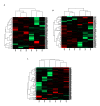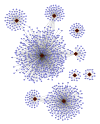Identification of Potential Key Long Non-Coding RNAs and Target Genes Associated with Pneumonia Using Long Non-Coding RNA Sequencing (lncRNA-Seq): A Preliminary Study
- PMID: 27663962
- PMCID: PMC5040222
- DOI: 10.12659/msm.900783
Identification of Potential Key Long Non-Coding RNAs and Target Genes Associated with Pneumonia Using Long Non-Coding RNA Sequencing (lncRNA-Seq): A Preliminary Study
Abstract
BACKGROUND This study aimed to identify the potential key long non-coding RNAs (lncRNAs) and target genes associated with pneumonia using lncRNA sequencing (lncRNA-seq). MATERIAL AND METHODS A total of 9 peripheral blood samples from patients with mild pneumonia (n=3) and severe pneumonia (n=3), as well as volunteers without pneumonia (n=3), were received for lncRNA-seq. Based on the sequencing data, differentially expressed lncRNAs (DE-lncRNAs) were identified by the limma package. After the functional enrichment analysis, target genes of DE-lncRNAs were predicted, and the regulatory network was constructed. RESULTS In total, 99 DE-lncRNAs (14 upregulated and 85 downregulated ones) were identified in the mild pneumonia group and 85 (72 upregulated and 13 downregulated ones) in the severe pneumonia group, compared with the control group. Among these DE-lncRNAs, 9 lncRNAs were upregulated in both the mild and severe pneumonia groups. A set of 868 genes were predicted to be targeted by these 9 DE-lncRNAs. In the network, RP11-248E9.5 and RP11-456D7.1 targeted the majority of genes. RP11-248E9.5 regulated several genes together with CTD-2300H10.2, such as QRFP and EPS8. Both upregulated RP11-456D7.1 and RP11-96C23.9 regulated several genes, such as PDK2. RP11-456D7.1 also positively regulated CCL21. CONCLUSIONS These novel lncRNAs and their target genes may be closely associated with the progression of pneumonia.
Figures


Similar articles
-
LncRNA RP11-248E9.5 and RP11-456D7.1 are Valuable for the Diagnosis of Childhood Pneumonia.Int J Gen Med. 2021 Mar 17;14:895-902. doi: 10.2147/IJGM.S291239. eCollection 2021. Int J Gen Med. 2021. PMID: 33762841 Free PMC article.
-
Genetic landscape of long noncoding RNA (lncRNAs) in glioblastoma: identification of complex lncRNA regulatory networks and clinically relevant lncRNAs in glioblastoma.Oncotarget. 2018 Jul 3;9(51):29548-29564. doi: 10.18632/oncotarget.25434. eCollection 2018 Jul 3. Oncotarget. 2018. PMID: 30038703 Free PMC article.
-
Comprehensive long non-coding RNA expression profiling by RNA sequencing reveals potential biomarkers for acute myeloid leukemia risk.Cancer Biomark. 2019;26(1):93-108. doi: 10.3233/CBM-190215. Cancer Biomark. 2019. PMID: 31356197
-
Long non-coding RNAs in human early embryonic development and their potential in ART.Hum Reprod Update. 2016 Dec;23(1):19-40. doi: 10.1093/humupd/dmw035. Epub 2016 Sep 21. Hum Reprod Update. 2016. PMID: 27655590 Review.
-
Elucidating the Role of Host Long Non-Coding RNA during Viral Infection: Challenges and Paths Forward.Vaccines (Basel). 2017 Oct 20;5(4):37. doi: 10.3390/vaccines5040037. Vaccines (Basel). 2017. PMID: 29053596 Free PMC article. Review.
Cited by
-
The effect of N6-methyladenosine (m6A) factors on the development of acute respiratory distress syndrome in the mouse model.Bioengineered. 2022 Mar;13(3):7622-7634. doi: 10.1080/21655979.2022.2049473. Bioengineered. 2022. PMID: 35263199 Free PMC article.
-
LncRNA SNHG16 is Downregulated in Pneumonia and Downregulates miR-210 to Promote LPS-Induced Lung Cell Apoptosis.Mol Biotechnol. 2023 Mar;65(3):446-452. doi: 10.1007/s12033-022-00545-6. Epub 2022 Aug 22. Mol Biotechnol. 2023. PMID: 35994228
-
Upregulated expression of long non-coding RNA MEG3 serves as a prognostic biomarker in severe pneumonia children and its regulatory mechanism.Bioengineered. 2021 Dec;12(1):7120-7131. doi: 10.1080/21655979.2021.1979351. Bioengineered. 2021. PMID: 34558385 Free PMC article.
-
Long Noncoding RNA: A Novel Insight into the Pathogenesis of Acute Lung Injury.J Clin Med. 2023 Jan 11;12(2):604. doi: 10.3390/jcm12020604. J Clin Med. 2023. PMID: 36675533 Free PMC article. Review.
-
Diagnostic and Prognostic Value of Deregulated Circulating Long Non-coding RNA TUG1 in Elderly Patients with Severe Pneumonia.Inflammation. 2023 Feb;46(1):313-321. doi: 10.1007/s10753-022-01735-9. Epub 2022 Sep 15. Inflammation. 2023. PMID: 36104517
References
-
- Shahcheraghi F, Moezi H, Feizabadi MM. Distribution of TEM and SHV beta-lactamase genes among Klebsiella pneumoniae strains isolated from patients in Tehran. Med Sci Monit. 2007;13(11):BR247–50. - PubMed
-
- Thomas CP, Ryan M, Chapman JD, et al. Incidence and cost of pneumonia in Medicare beneficiaries. Chest. 2012;142:973–81. - PubMed
-
- Lutfiyya MN, Henley E, Chang LF, Reyburn SW. Diagnosis and treatment of community-acquired pneumonia. Am Fam Physician. 2006;73:442–50. - PubMed
-
- Cillóniz C, Torres A, Niederman M, et al. Community-acquired pneumonia related to intracellular pathogens. Intensive Care Med. 2016;42(9):1374–86. - PubMed
LinkOut - more resources
Full Text Sources
Other Literature Sources

